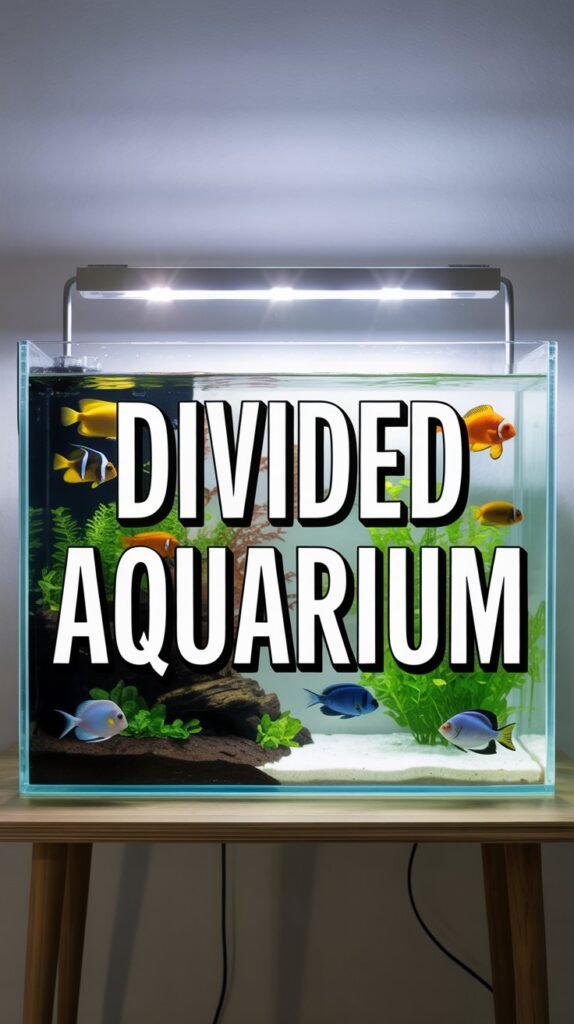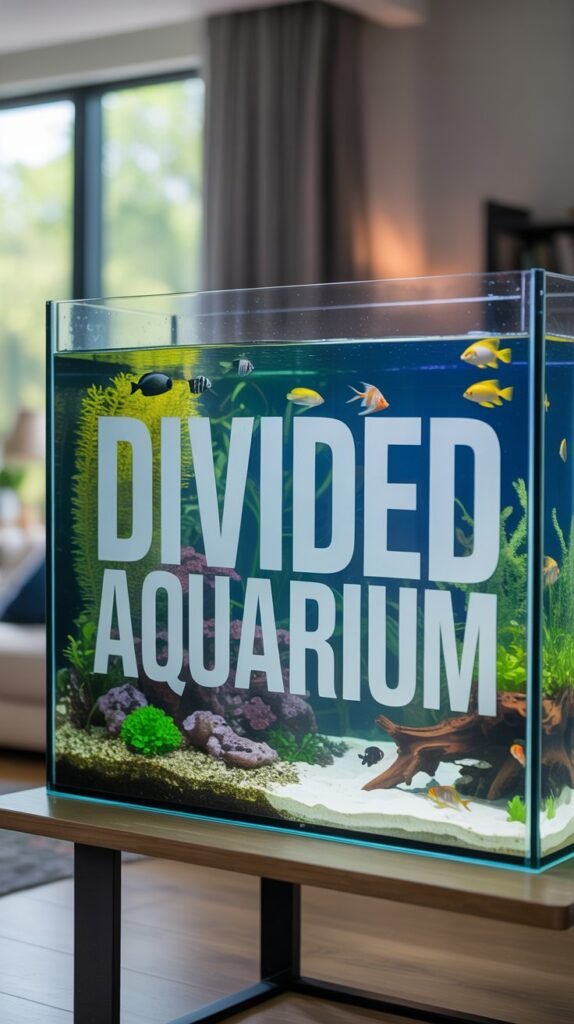Aquariums are a beautiful and peaceful addition to any home or office, but managing multiple fish species or separating aggressive ones can sometimes be challenging. This is where a divided aquarium becomes an excellent solution. A divided aquarium allows you to split one tank into two or more sections, creating separate environments for different fish while using the same filtration, lighting, and heating system.
In this comprehensive guide, we’ll explore everything about divided aquariums — from what they are, their benefits, and how to set them up, to maintenance tips and frequently asked questions. Whether you’re a beginner or an experienced aquarist, this guide will help you design and maintain a successful divided aquarium system.
What Is a Divided Aquarium?
A divided aquarium is a single fish tank that’s been partitioned into two or more sections using a divider. This divider can be made of acrylic, glass, mesh, or plastic, depending on your needs. Each section can house different fish species, breeding pairs, or even serve as a nursery for fry.
Dividers are usually designed to allow water flow between compartments while preventing fish from crossing over. This ensures that all sections share the same water conditions, filtration, and temperature, but each remains physically separate.
Divided aquariums are commonly used for bettas, guppies, and breeding fish, but they can be adapted for many species.
Why Choose a Divided Aquarium?

There are many practical and aesthetic reasons to use a divided aquarium setup. Let’s take a closer look at the main benefits.
1. Separation of Aggressive Fish
Some fish, like male bettas or territorial guppies, cannot coexist peacefully in the same tank. A divider prevents fights and injuries while allowing you to keep multiple fish in one setup.
2. Breeding Purposes
Divided tanks are perfect for breeding fish. You can keep males and females separated until you’re ready to breed them. Once they spawn, fry can be kept safe in another section.
3. Quarantine or Hospital Section
If a fish becomes sick or injured, a divided section can serve as a quarantine area for treatment without the need for a separate tank.
4. Efficient Use of Space
Instead of buying multiple tanks, you can use one large aquarium and divide it into sections for different species or breeding projects.
5. Easy Maintenance
All compartments share the same filtration and heating system, making maintenance much simpler and more cost-effective than managing multiple tanks.
6. Enhanced Aesthetics
A divided aquarium can be visually stunning. With proper aquascaping, lighting, and layout, you can design each section uniquely while maintaining overall harmony.
Types of Aquarium Dividers
There are several types of dividers available, depending on your fish species, tank size, and design preference.
1. Mesh Dividers
- Made from plastic or nylon mesh.
- Allows excellent water circulation and filtration.
- Ideal for betta fish or guppies.
- Easy to install and remove.
Cons: Smaller fish or fry may slip through the holes if the mesh is too large.
2. Acrylic or Glass Dividers
- Solid and durable material.
- Provides complete physical separation between sections.
- Prevents aggressive fish from seeing each other, reducing stress.
- Ideal for territorial fish species.
Cons: Limits water circulation, so you may need additional aeration or filtration.
3. Plastic Canvas Dividers
- Inexpensive and easy to customize.
- Commonly used for DIY divided tanks.
- Provides good water flow with minimal visual obstruction.
Cons: Not as durable as glass or acrylic; may warp over time.
4. Adjustable Dividers
- Commercially available adjustable dividers fit various tank sizes.
- Great for flexible setups or temporary separations.
Cons: Usually more expensive than DIY options.
Setting Up a Divided Aquarium

A divided aquarium setup may sound complicated, but with proper planning, it’s quite simple. Below is a step-by-step guide to help you get started.
Step 1: Choose the Right Tank Size
Your tank size depends on how many sections you want and what species you plan to keep. For example:
- 10-gallon tank: Perfect for 2–3 small fish sections.
- 20–40 gallon tank: Ideal for multiple species or breeding setups.
Ensure that each fish has adequate space, filtration, and hiding areas.
Step 2: Select the Divider Type
Decide whether you need a mesh, acrylic, or glass divider. Mesh or perforated dividers are ideal for community or breeding tanks, while solid dividers work better for aggressive or territorial fish.
Step 3: Install the Divider
- Measure your tank accurately to ensure a snug fit.
- Cut the divider if needed, and attach it using suction cups, clips, or silicone sealant.
- Ensure it’s secure and stable, with no gaps at the top or bottom for fish to pass through.
If you use a mesh divider, position it so that it allows water to flow freely between sections.
Step 4: Add Filtration and Heating
All sections of the divided aquarium share the same water, so one central filtration and heating system is usually enough.
- Use a sponge filter or HOB (hang-on-back) filter for even water distribution.
- Place a heater near the filter output to ensure consistent temperature across all compartments.
Step 5: Decorate Each Section
Aquascaping enhances both the beauty and functionality of your divided tank. Add:
- Plants: Live or artificial for cover and oxygenation.
- Rocks or driftwood: To provide hiding spaces.
- Substrate: Gravel or sand for biological filtration.
Try to decorate each section uniquely to help you distinguish them easily.
Step 6: Add Water and Condition It
Fill the tank slowly with dechlorinated water to avoid disturbing the dividers or decorations. Ensure proper water parameters according to the species you plan to keep.
Step 7: Introduce Your Fish
Once the tank is cycled and stable, add your fish gradually. Observe them for a few days to ensure no stress or water quality issues arise.
Best Fish for a Divided Aquarium
A divided aquarium works best with small or medium-sized species. Here are some good options:
1. Betta Fish
The most popular choice for divided tanks. Male bettas are territorial and must be separated, but they thrive in divided setups.
2. Guppies
Different strains or breeding pairs of guppies can be kept separately for breeding control.
3. Endler’s Livebearers
Colorful, peaceful, and small—great for small sections of divided aquariums.
4. Shrimp
A divided tank can help separate different shrimp species or protect juveniles from predators.
5. Breeding Pairs
Use dividers to separate males and females until spawning time, or keep fry safe from adult fish.
Maintaining a Divided Aquarium

Maintenance is crucial for keeping your divided aquarium healthy and balanced.
1. Regular Water Changes
Perform 20–30% water changes weekly to maintain water quality. Since all sections share water, waste from one compartment affects all.
2. Clean the Dividers
Over time, algae and debris can build up on dividers, restricting water flow. Gently clean them during water changes.
3. Monitor Filtration and Water Flow
Ensure water circulates evenly through all sections. Dead spots may cause ammonia buildup.
4. Test Water Parameters
Check for ammonia, nitrite, nitrate, and pH regularly. A divided aquarium relies heavily on stable water chemistry.
5. Feed Fish Separately
Feed fish in each section individually to prevent food waste and aggression through the divider.
Common Problems and Solutions
Problem 1: Water Flow Blockage
If the divider restricts water movement, debris may accumulate.
Solution: Use a sponge filter or add an air stone for improved circulation.
Problem 2: Fish Jumping Over the Divider
Some fish, like bettas, may jump over dividers.
Solution: Keep the water level slightly below the top of the divider or cover the tank with a lid.
Problem 3: Algae Growth
Shared lighting can cause excess algae on dividers.
Solution: Reduce light exposure or introduce algae-eating species in one compartment.
Problem 4: Uneven Temperature
If your heater isn’t well-positioned, some sections may be cooler.
Solution: Place the heater near the filter output for even heat distribution.
DIY Divided Aquarium Ideas
You don’t always have to buy a ready-made divider—there are many DIY options.
1. Plastic Canvas Divider
Cut a plastic canvas sheet to size and secure it with suction cups. It’s affordable and easy to clean.
2. Mesh and Binder Spines
Attach mesh to plastic binder spines and wedge them into the tank. This is a flexible and removable option.
3. Acrylic Sheet Divider
Cut and drill small holes in an acrylic sheet for water flow. Silicone it in place for a permanent solution.
DIY dividers are budget-friendly and customizable for any tank size.
Advantages of a Divided Aquarium
- Saves space and resources
- Allows for multiple species in one tank
- Easy to maintain and clean
- Perfect for breeding and quarantine
- Reduces aggression among fish
- Provides creative aquascaping opportunities
Disadvantages of a Divided Aquarium
- Water quality in one section affects all
- Limited swimming space for each fish
- Requires careful setup to prevent escapes
- Aggressive fish may stress others if dividers are see-through
Tips for Success with Divided Aquariums
- Plan your layout before installation.
- Match species that thrive in similar water parameters.
- Avoid overcrowding each section.
- Keep extra dividers on hand for adjustments.
- Observe fish behavior regularly for signs of stress.
- Use opaque dividers for aggressive species to reduce stress.
- Perform consistent maintenance to ensure overall tank health.
Conclusion
A divided aquarium is a creative and efficient way to keep multiple fish in one system while maintaining harmony and safety. It’s perfect for betta keepers, breeders, and aquarists who want to maximize their space without compromising the well-being of their fish.
By understanding how to set up and maintain a divided aquarium properly, you can create a visually appealing, functional, and peaceful aquatic environment. Whether for breeding, quarantine, or showcasing multiple species, divided aquariums offer endless possibilities for every fish lover.
FAQs About Divided Aquariums
1. What size tank is best for a divided aquarium?
A 10-gallon tank is ideal for two to three small fish sections. For larger setups or more divisions, go for 20 to 40 gallons.
2. Can I divide any aquarium?
Yes, most glass or acrylic tanks can be divided, as long as the divider fits securely and allows proper water flow.
3. What fish are best for divided aquariums?
Betta fish, guppies, Endlers, and small livebearers are great options for divided setups.
4. Can I use a divided aquarium for breeding?
Absolutely. It’s ideal for separating breeding pairs or protecting fry from adult fish.
5. How do I keep water circulating in all sections?
Use a sponge filter or air stone to ensure even water flow throughout the tank.
6. Should I use see-through or opaque dividers?
For aggressive fish like bettas, opaque dividers are better to reduce stress. For peaceful fish, transparent dividers are fine.
7. Can water parameters differ between sections?
No, all sections share the same water, so parameters will remain the same across the tank.
8. How do I prevent fish from jumping over the divider?
Keep the water level slightly below the divider’s top edge or use a tight-fitting lid.
9. Do I need separate filters for each section?
No, a single filtration system is usually enough if water can flow freely between sections.
10. How often should I clean a divided aquarium?
Perform partial water changes every week and clean dividers during maintenance to prevent buildup and algae growth.
Final Thoughts:
A divided aquarium is an excellent way to make the most of your aquarium space, especially if you want to keep multiple species or separate fish safely. With proper setup, maintenance, and care, your divided tank will be a thriving, visually stunning aquatic ecosystem that both you and your fish can enjoy.

